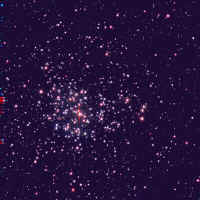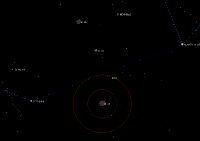M37 (open cluster in Auriga)
370:
M37
M37 is the brightest and tightest of the three open clusters in Auriga. Even so, Le Gentil missed M37 when he rediscovered M36 and M38 in 1749, leaving it up to Charles Messier to rediscover M37 independently on September 2, 1764, the same day he logged M36. M37 is the also the richest of the three open clusters in Auriga, comprising perhaps 500 total stars, of which about 150 are brighter than magnitude 12.5. At 300 million years or so, M37 is a middle-aged open cluster. Its distance is variously estimated as between 3,600 and 4,700 light years, and its visible extent is a circle of about 24 arcminutes, or about 80% the diameter of the full moon. Unlike many open clusters, which are loose enough that a novice may not recognize them as clusters, M37 is tight enough to be obvious even to a beginner.
380: M37 with the Telrad
Getting M37 into your scope’s field of view is pretty easy. Use the imaginary line joining the two Auriga pentagram stars 37 Theta Auriga and Alnath. Place your Telrad as shown, with the bulk of its field outside the pentagram with the 4-degree circle just touching the line between 37 Theta Auriga and Alnath at about 40% of the distance from 37 Theta Auriga to Alnath. M37 should appear in your low-power eyepiece, although you can verify its location with your optical finder and center it if necessary. Like other open clusters, M37 is a low- to medium-power object. Its extent is a circle of about 24 arcminutes, or twice the size of M36 and about 80% the diameter of the full moon. That means an eyepiece with a true field of view of 45 arcminutes or so allows you to view the details of the cluster in context with its surroundings.

